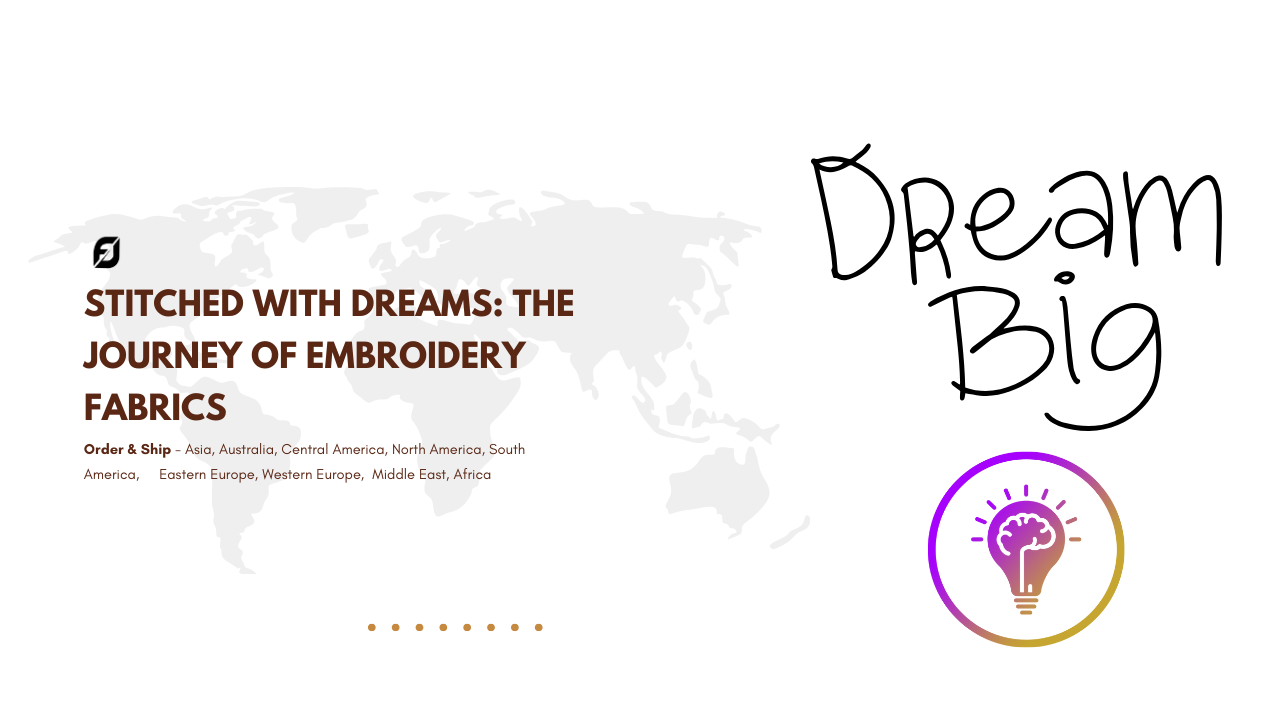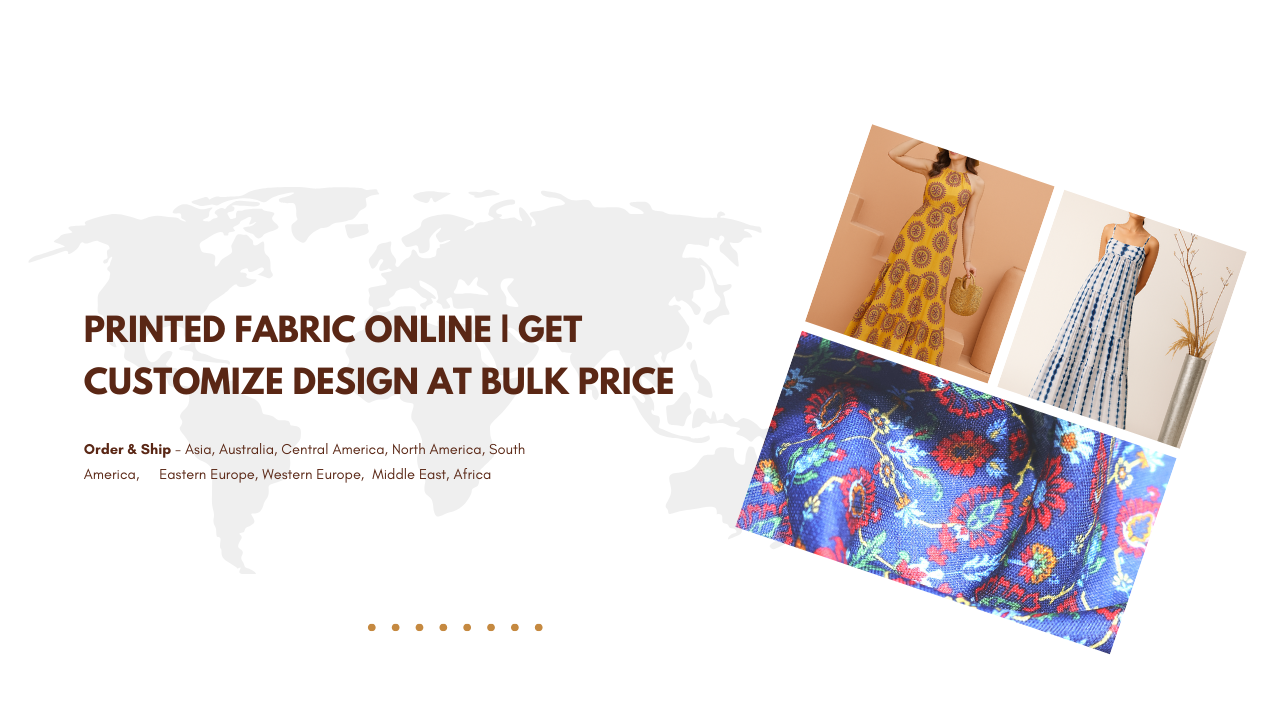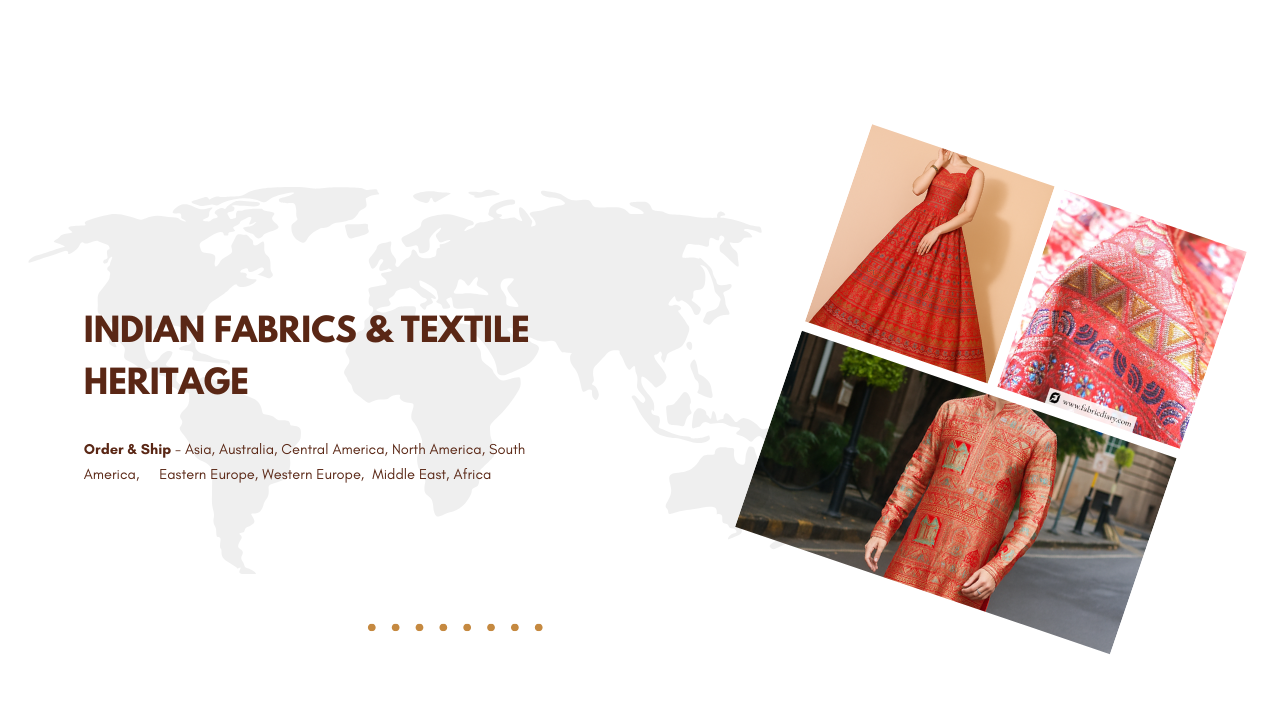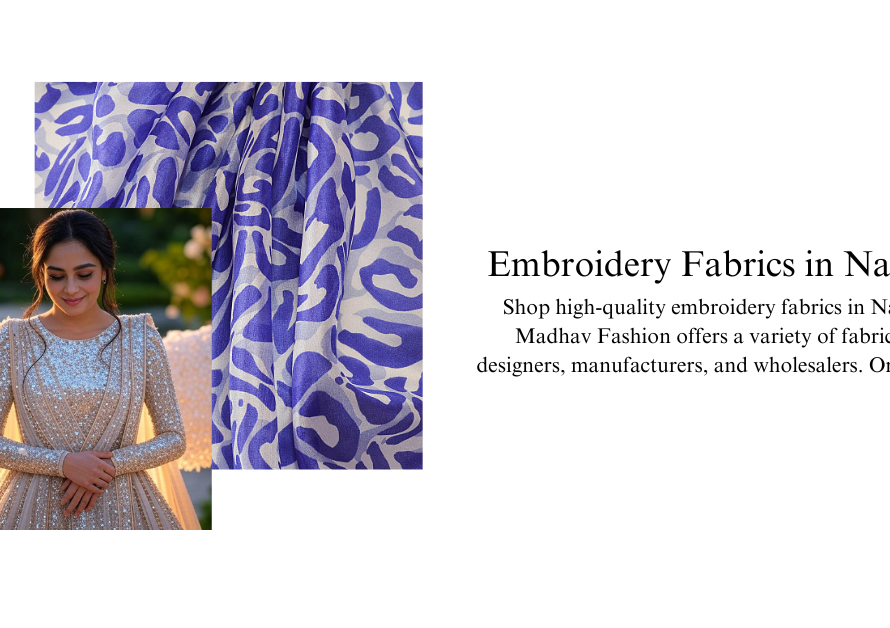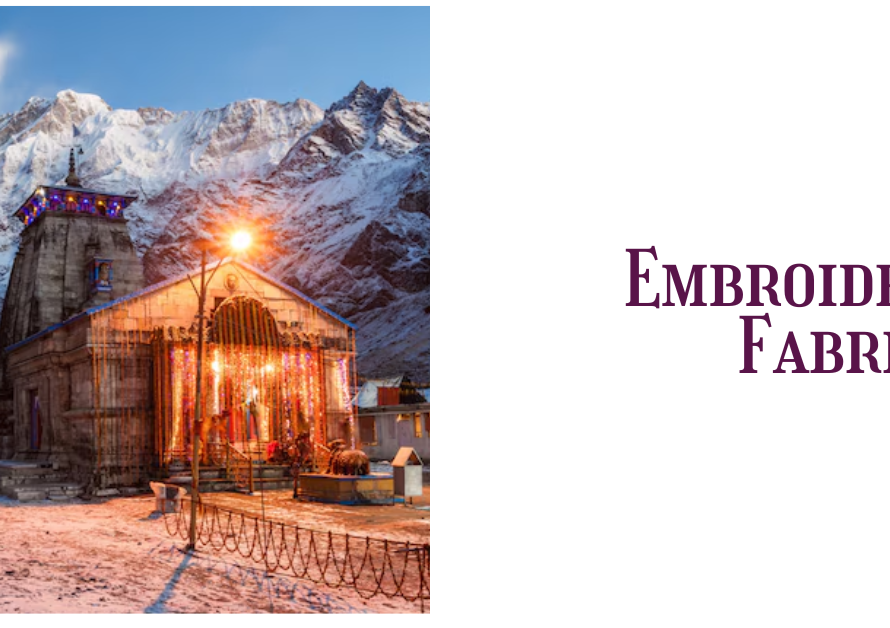In the world of luxury fashion, fabric is more than just a material—it’s the foundation of design, the essence of craftsmanship, and the soul of couture. Among the many exquisite textiles that define high-end fashion, threadwork embroidered fabric on georgette stands out for its elegance, intricate detailing, and timeless appeal.
Madhav Fashion’s embroidered fabrics offer designers a canvas to create statement pieces—whether it’s a flowing evening gown, a structured dress, or a red-carpet masterpiece. But working with such delicate fabric requires an understanding of design, structure, and precision. Here’s how a designer transforms embroidered georgette into a breathtaking gown, step by step.
How to Create a Stunning Gown with Madhav Fashions Threadwork Embroidered Georgette Fabric
Concept Development – The Vision Behind the Gown
Every great design starts with a vision. When working with embroidered georgette, the first step is defining the silhouette and mood of the gown. Do you envision a romantic, flowing ensemble with soft drapes, or a sculpted, contemporary design with dramatic cuts?
Understanding the embroidery placement is crucial. Since the fabric already has intricate threadwork, the design must enhance, not overpower, its beauty. The goal is to create harmony between fabric, embroidery, and silhouette.
Choosing the Right Color Palette
Color plays a pivotal role in defining the personality of the gown. Soft pastels like blush, ivory, and lavender exude grace and femininity, making them perfect for bridal or ethereal looks. Deep hues like emerald, burgundy, and midnight blue add drama and opulence, ideal for evening wear.
The embroidery itself influences the color choice. If the fabric features gold or silver threadwork, pairing it with a complementary or contrasting base fabric can create a stunning visual impact.
Fabric Study – Understanding Embroidered Georgette
Madhav Fashion’s threadwork embroidered georgette is a lightweight yet richly detailed fabric. While the georgette base provides a fluid drape, the embroidery adds structure and weight. This balance makes it perfect for gowns, but also requires careful handling.
Key considerations include:
Drape & Movement: Georgette flows beautifully, making it ideal for flared or layered designs.
Embroidery Placement: Strategic positioning ensures symmetry and enhances the garment’s overall aesthetic.
Lining & Support: Depending on the embroidery density, an additional lining may be needed to maintain structure and comfort.
Precision Cutting & Pattern Making
Unlike plain fabrics, embroidered textiles demand strategic cutting to preserve motifs and maintain symmetry. Before cutting, the designer carefully marks areas where embroidery should align with the bodice, sleeves, or hemline.
Key aspects to consider:
Seam Placement: Avoid cutting through heavy embroidery to prevent fraying or distortion. Motif Alignment: Ensuring the embroidery flows seamlessly across different garment sections.
Reinforcement: Some areas may require interfacing to maintain structure, especially in bodices or fitted sections.
Stitching & Construction – Bringing the Design to Life
The sewing process for an embroidered gown is meticulous. Since embroidered georgette is delicate, hand-finishing techniques are often used to maintain its integrity.
Seam Finishing: French seams or binding help prevent fraying and ensure a clean finish. Lining & Layering: A silk or satin lining enhances the comfort and luxurious feel of the gown.
Additional Embellishments: Beading, lace, or sheer overlays can elevate the design while complementing the embroidery.
A well-constructed gown is not just about aesthetics—it’s about comfort, durability, and fluid movement.
Fitting & Refinements – The Couture Touch
A couture gown is defined by its fit and flow. Multiple fittings ensure that the gown drapes flawlessly on the body, enhancing the wearer’s posture and movement.
Adjusting Hemlines & Silhouettes: Ensuring the gown falls gracefully without overwhelming the frame.
Refining Necklines & Sleeves: Enhancing the embroidery’s visibility and balance in the overall design.
Hidden Closures & Finishings: Invisible zippers, hand-sewn hooks, or corsetry ensure a polished look.
Every inch of the gown should feel intentional, from the first stitch to the final fitting.
The Final Look – A Masterpiece Unveiled
Once the construction is complete, final touches such as steaming, pressing, and embellishment refinements take the gown from a design sketch to a runway-worthy piece.
The end result? A breathtaking gown that seamlessly blends craftsmanship, luxury, and the timeless beauty of Madhav Fashion’s threadwork embroidered fabric. Whether it graces a grand wedding, a high-fashion editorial, or an exclusive soirée, it is a testament to the art of couture.
The Fabric of Dreams
Fashion is more than just clothing—it’s a form of self-expression, a reflection of artistry, and a bridge between tradition and modernity. Working with embroidered georgette requires skill, patience, and vision, but the result is always worth it.
Madhav Fashion’s threadwork fabric is not just a textile—it’s an invitation to create something extraordinary. Whether you’re a designer, a fashion enthusiast, or someone who appreciates the beauty of couture, the journey of transforming fabric into a masterpiece is nothing short of magical.
___________________________
What makes threadwork embroidered fabric ideal for couture gowns?
Threadwork embroidered fabric, especially on georgette, is a perfect choice for couture gowns due to its luxurious texture, intricate detailing, and elegant drape. The embroidery adds depth and dimension, making the fabric visually rich and appealing. Designers love working with embroidered fabrics because they bring an artisanal touch to garments, elevating them from simple silhouettes to statement pieces.
Additionally, threadwork embroidery can range from delicate and subtle to bold and heavily embellished, offering versatility for different gown styles. The fabric flows beautifully, allowing designers to craft ethereal gowns with soft draping or structured masterpieces with precision tailoring. However, because of the embroidery, it requires careful handling in pattern making, cutting, and stitching to ensure symmetry and a refined finish.
When choosing threadwork embroidered fabric for a gown, it’s essential to consider the embroidery density, fabric weight, and the occasion for which the gown is being designed. Whether it’s a wedding gown, an evening dress, or a red-carpet ensemble, this fabric brings a sense of opulence and sophistication that is unmatched in the world of fashion.
How should designers choose the right embroidered fabric for a gown?
Selecting the right embroidered fabric for a gown depends on several factors, including the embroidery type, fabric base, and design vision. One of the first considerations is the density of embroidery—heavily embroidered fabrics are best suited for structured gowns, while lighter embroidery works well for flowing, romantic silhouettes.
The fabric base is equally important. Georgette embroidered fabrics are ideal for gowns due to their drape and lightweight nature, but if a more structured look is required, a silk or organza base may be a better choice. The fabric should complement the gown’s silhouette and movement, ensuring comfort and elegance.
Color is another essential element. Designers should choose a shade that enhances the embroidery details and aligns with the mood of the gown. Pastels exude softness, while jewel tones offer a regal touch. The embroidery thread color should harmonize with the base fabric—contrasting embroidery creates a bold effect, while tone-on-tone embroidery delivers subtle sophistication.
Finally, designers should consider how the fabric will be cut and constructed. Since embroidery patterns need to be aligned perfectly, strategic planning is necessary before cutting and stitching.
What are the challenges of working with embroidered georgette fabric?
While embroidered georgette fabric is stunning, working with it presents some challenges that designers must navigate carefully. One of the primary concerns is fabric fragility—georgette is lightweight and delicate, which makes it prone to fraying, especially around the embroidered sections. This requires careful seam finishing techniques such as French seams or binding to ensure durability.
Another challenge is cutting and aligning embroidery motifs. Unlike plain fabrics, embroidered fabrics must be cut strategically to preserve symmetry and design continuity. If motifs are not aligned properly, the final gown may look uneven or unbalanced. Precision in pattern placement and fabric marking is crucial before cutting.
Stitching can also be difficult due to the added weight of the embroidery. Heavy threadwork may make some sections stiff, requiring reinforcement in certain areas while ensuring flexibility in others. Hand-sewing and specialized needles are often needed to handle these intricacies without damaging the fabric.
Lastly, embroidered georgette can sometimes be sheer, necessitating the right choice of lining to provide coverage while maintaining the fabric’s natural fluidity.
How can embroidery placement enhance the overall design of a gown?
Embroidery placement is a crucial design element that defines the elegance and visual appeal of a gown. When used effectively, it can highlight key areas of the garment while ensuring balance and proportion. For example, embroidery concentrated around the bodice and cascading down the skirt creates a focal point, drawing attention to the upper body while maintaining a soft, flowing effect.
For structured gowns, symmetrical embroidery on both sides ensures uniformity, while asymmetrical embroidery adds a contemporary edge. Designers often use strategic placement to enhance body proportions—vertical embroidery elongates the figure, whereas horizontal patterns create a broader look.
If the gown features sleeves, high necklines, or backless designs, embroidery can be placed to accentuate these features elegantly. Sheer sections with embroidered overlays create a delicate, ethereal effect, adding depth without overwhelming the design.
Understanding how light interacts with embroidery also plays a role. Metallic threads or sequins placed at strategic angles catch the light, creating a luminous, dynamic effect as the wearer moves. By planning embroidery placement thoughtfully, designers can craft gowns that are both visually striking and timeless.
What is the best way to line an embroidered georgette gown?
Lining an embroidered georgette gown is essential for enhancing comfort, structure, and opacity while preserving the beauty of the embroidery. Since georgette is a lightweight, slightly sheer fabric, the lining should complement its natural flow without adding unnecessary bulk.
The choice of lining fabric depends on the desired final look. Silk or satin linings add a luxurious feel and ensure smooth movement, making them perfect for evening gowns. Chiffon or crepe linings provide a lighter, breathable option while maintaining the gown’s ethereal quality.
One of the key considerations is how the embroidery interacts with the lining. If the embroidery is heavy, a sturdier lining like duchess satin or organza may be required for support. In contrast, for softer, flowing gowns, lightweight linings are preferable to maintain fluidity.
Lining should be attached carefully to avoid disrupting the embroidery. Hand-stitching or using soft seam allowances prevents bulkiness. Additionally, invisible zippers or hand-finished closures maintain a seamless look.
By selecting the right lining and construction method, designers ensure that the gown remains comfortable, retains its shape, and enhances the beauty of the embroidered fabric.
What stitching techniques work best for embroidered georgette fabric?
Since embroidered georgette fabric is delicate and can fray easily, the right stitching techniques are essential for durability and refinement. French seams are one of the best options, as they provide a clean, polished finish without adding bulk. This method encloses raw edges within a second seam, preventing fraying while maintaining elegance.
For gowns with sheer or lightweight sections, rolled hems ensure that the fabric edges remain neat without appearing heavy. Hand-sewing techniques such as invisible stitches and slip-stitching are often used in couture gowns to preserve the embroidery’s beauty without visible machine stitching.
When sewing through heavy embroidery, a fine needle and slow stitching speed help prevent thread breakage. Sometimes, hand-sewing is necessary for intricate areas to avoid damaging the embroidery.
Additionally, for structured gowns, boning or interfacing may be needed in certain areas to provide support without compromising the fabric’s natural movement.
Using these techniques ensures that the final gown is not only visually stunning but also expertly constructed for longevity and comfort.
How can designers ensure the perfect fit when working with embroidered fabric?
Achieving the perfect fit with embroidered georgette fabric requires meticulous planning, multiple fittings, and precision tailoring. Since embroidery adds texture and weight to the fabric, the fit must be balanced between comfort and structure to ensure an elegant drape.
One of the first steps is choosing the right pattern. Unlike plain fabrics, embroidered textiles require strategic pattern placement to align motifs symmetrically. Designers often create a mock-up (muslin or toile) before cutting the actual fabric, allowing adjustments without risking damage to the embroidery.
During fittings, designers must focus on how the embroidery interacts with the body’s natural movement. Heavy embroidery on stiff sections may restrict mobility, so side panels, darts, and pleats should be incorporated strategically for ease.
To maintain the gown’s shape, boning or inner corsetry can be used in structured designs, while fluid gowns may require bias cuts to enhance the natural drape of the fabric. Invisible zippers or hook-and-eye closures should be placed carefully to avoid disrupting embroidery patterns.
Regular fittings, final seam refinements, and hand-finished adjustments ensure that the gown fits flawlessly, allowing the embroidered fabric to shine while maintaining comfort and sophistication.
How can designers prevent fraying and damage when cutting embroidered georgette?
Cutting embroidered georgette requires a specialized approach to prevent fraying and maintain the integrity of the embroidery. Since georgette is naturally delicate and prone to unraveling, designers must use sharp tools, stabilize the fabric, and plan cutting strategically.
One of the best techniques is placing the fabric between tissue paper layers before cutting. This prevents excessive movement, allowing clean cuts without pulling the embroidery threads. A rotary cutter or fine embroidery scissors are recommended over regular shears, as they provide precision without causing fabric stress.
Marking the fabric should be done carefully, preferably with tailor’s chalk or basting stitches rather than sharp markers that can stain delicate fibers. Heat-sealing or pinking shears may be used for edges, but overlocking or French seams provide the most professional and durable finish.
When embroidery patterns are close to seam lines, designers may need to remove excess embroidery carefully before stitching to avoid bulky seams. Reinforcing the fabric with lightweight fusible interfacing in key areas prevents fraying while preserving the fabric’s natural movement.
By using these careful cutting techniques, designers can ensure that the embroidered georgette fabric remains intact and stunning throughout the gown-making process.
What are some styling tips for wearing embroidered georgette gowns?
Wearing an embroidered georgette gown is all about balancing elegance and personal style. Since the fabric itself is already detailed and visually rich, styling should enhance rather than overpower the gown’s beauty.
For formal events, pairing the gown with minimalist jewelry allows the embroidery to remain the focal point. Diamond or pearl earrings, delicate bracelets, or a statement ring work well without overshadowing the intricate threadwork. If the gown has gold or silver embroidery, matching metallic accessories create a cohesive look.
Shoes should be chosen based on the gown’s length and style. Strappy heels or embellished stilettos complement evening gowns, while elegant flats or kitten heels work well for a more relaxed yet sophisticated appearance.
For hairstyles, soft curls, sleek buns, or romantic updos beautifully frame the embroidery on high-neck or back-detailed gowns. If the gown has a deep neckline, a chignon or side-swept hairdo keeps the focus on the embroidery.
Finally, makeup should align with the gown’s color palette—neutral tones for pastels, bold lips for jewel tones, and soft glam for metallic hues. With the right styling, an embroidered georgette gown becomes a timeless statement of luxury and grace.


